UNITED STATES
SECURITIES AND EXCHANGE COMMISSION
Washington, D.C. 20549
FORM 8-K
CURRENT REPORT
Pursuant to Section 13 or 15(d) of the
Securities Exchange Act of 1934
Date of Report (Date of earliest event reported): August 9, 2017
MB FINANCIAL, INC. | ||||
(Exact name of registrant as specified in its charter) | ||||
Maryland | 001-36599 | 36-4460265 | ||
(State or other jurisdiction of incorporation) | (Commission File No.) | (IRS Employer Identification No.) | ||
800 West Madison Street, Chicago, Illinois 60607 | ||||
(Address of principal executive offices) (Zip Code) | ||||
Registrant’s telephone number, including area code: (888) 422-6562 | ||||
N/A | ||||
(Former name or former address, if changed since last report) | ||||
Check the appropriate box below if the Form 8-K filing is intended to simultaneously satisfy the filing obligation of the registrant under any of the following provisions:
[ ] Written communications pursuant to Rule 425 under the Securities Act (17 CFR 230.425)
[ ] Soliciting material pursuant to Rule 14a-12 under the Exchange Act (17 CFR 240.14a-12)
[ ] Pre-commencement communications pursuant to Rule 14d-2(b) under the Exchange Act (17 CFR 240.14d-2(b))
[ ] Pre-commencement communications pursuant to Rule 13e-4(c) under the Exchange Act (17CFR 240.13e-4(c))
Item 7.01. Regulation FD Disclosure
Forward-Looking Statements
When used in this Current Report on Form 8-K and in other reports filed with or furnished to the Securities and Exchange Commission (the “SEC”), in press releases or other public stockholder communications, or in oral statements made with the approval of an authorized executive officer, the words or phrases “believe,” “will,” “should,” “will likely result,” “are expected to,” “will continue” “is anticipated,” “estimate,” “project,” “plans,” or similar expressions are intended to identify “forward-looking statements” within the meaning of the Private Securities Litigation Reform Act of 1995. You are cautioned not to place undue reliance on any forward-looking statements, which speak only as of the date made. These statements may relate to our future financial performance, strategic plans or objectives, revenues or earnings projections, or other financial items. By their nature, these statements are subject to numerous uncertainties that could cause actual results to differ materially from those anticipated in the statements.
Important factors that could cause actual results to differ materially from the results anticipated or projected include, but are not limited to, the following: (1) expected revenues, cost savings, synergies and other benefits from the MB Financial-American Chartered merger might not be realized within the expected time frames or at all and costs or difficulties relating to integration matters, including but not limited to customer and employee retention, might be greater than expected; (2) the credit risks of lending activities, including changes in the level and direction of loan delinquencies and write-offs and changes in estimates of the adequacy of the allowance for loan losses, which could necessitate additional provisions for loan losses, resulting both from originated loans and loans acquired from other financial institutions; (3) competitive pressures among depository institutions; (4) interest rate movements and their impact on customer behavior, net interest margin and the value of our mortgage servicing rights; (5) the possibility that our mortgage banking business may experience increased volatility in its revenues and earnings and the possibility that the profitability of our mortgage banking business could be significantly reduced if we are unable to originate and sell mortgage loans at profitable margins or if changes in interest rates negatively impact the value of our mortgage servicing rights; (6) the impact of repricing and competitors’ pricing initiatives on loan and deposit products; (7) fluctuations in real estate values; (8) our ability to adapt successfully to technological changes to meet customers’ needs and developments in the market place; (9) the possibility that security measures implemented might not be sufficient to mitigate the risk of a cyber attack or cyber theft, and that such security measures might not protect against systems failures or interruptions; (10) our ability to realize the residual values of our direct finance, leveraged and operating leases; (11) our ability to access cost-effective funding; (12) changes in financial markets; (13) changes in economic conditions in general and in the Chicago metropolitan area in particular; (14) the costs, effects and outcomes of litigation; (15) new legislation or regulatory changes, including but not limited to the Dodd-Frank Wall Street Reform and Consumer Protection Act of 2010 (the “Dodd-Frank Act”) and regulations adopted thereunder, changes in capital requirements pursuant to the Dodd-Frank Act, changes in the interpretation and/or application of laws and regulations by regulatory authorities, other governmental initiatives affecting the financial services industry and changes in federal and/or state tax laws or interpretations thereof by taxing authorities; (16) changes in accounting principles, policies or guidelines; (17) our future acquisitions of other depository institutions or lines of business; and (18) future goodwill impairment due to changes in our business, changes in market conditions, or other factors.
MB Financial does not undertake any obligation to update any forward-looking statement to reflect circumstances or events that occur after the date on which the forward-looking statement is made.
Set forth below are investor presentation materials.
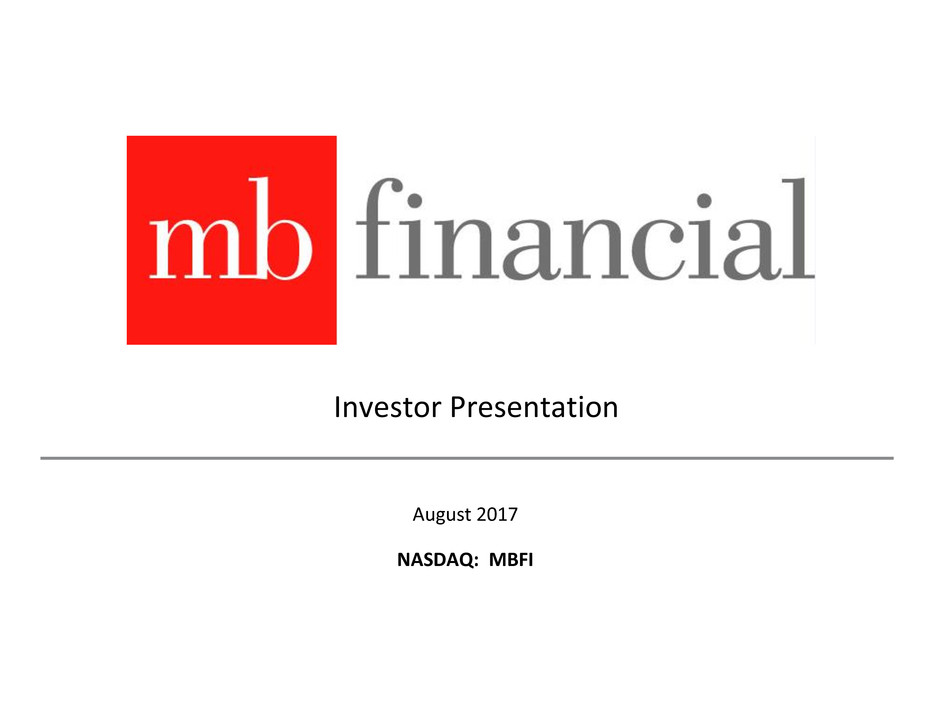
August 2017
NASDAQ: MBFI
Investor Presentation
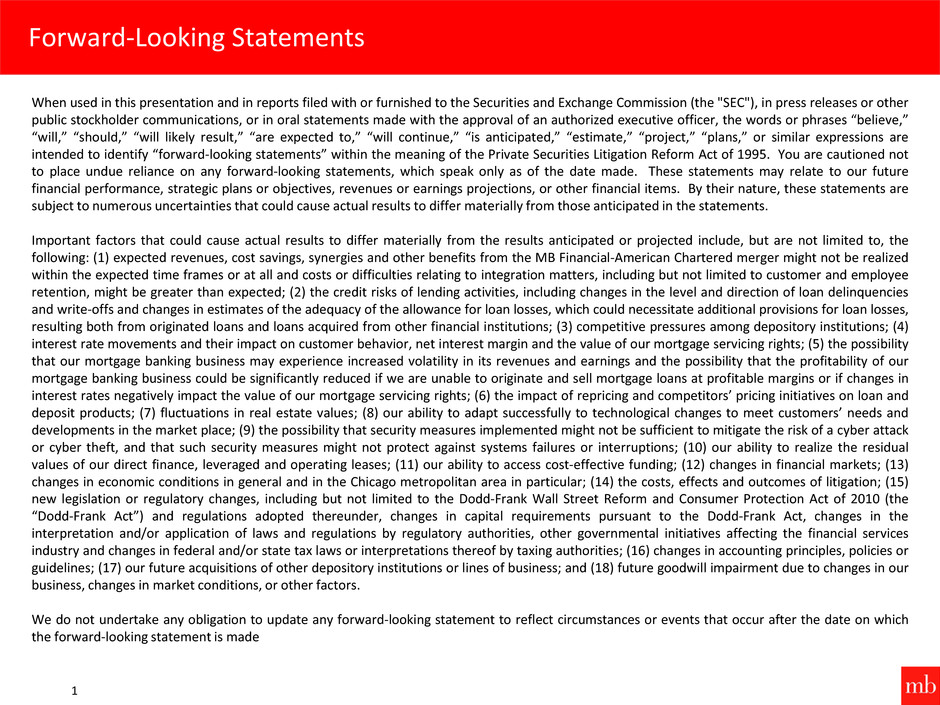
Forward-Looking Statements
1
When used in this presentation and in reports filed with or furnished to the Securities and Exchange Commission (the "SEC"), in press releases or other
public stockholder communications, or in oral statements made with the approval of an authorized executive officer, the words or phrases “believe,”
“will,” “should,” “will likely result,” “are expected to,” “will continue,” “is anticipated,” “estimate,” “project,” “plans,” or similar expressions are
intended to identify “forward-looking statements” within the meaning of the Private Securities Litigation Reform Act of 1995. You are cautioned not
to place undue reliance on any forward-looking statements, which speak only as of the date made. These statements may relate to our future
financial performance, strategic plans or objectives, revenues or earnings projections, or other financial items. By their nature, these statements are
subject to numerous uncertainties that could cause actual results to differ materially from those anticipated in the statements.
Important factors that could cause actual results to differ materially from the results anticipated or projected include, but are not limited to, the
following: (1) expected revenues, cost savings, synergies and other benefits from the MB Financial-American Chartered merger might not be realized
within the expected time frames or at all and costs or difficulties relating to integration matters, including but not limited to customer and employee
retention, might be greater than expected; (2) the credit risks of lending activities, including changes in the level and direction of loan delinquencies
and write-offs and changes in estimates of the adequacy of the allowance for loan losses, which could necessitate additional provisions for loan losses,
resulting both from originated loans and loans acquired from other financial institutions; (3) competitive pressures among depository institutions; (4)
interest rate movements and their impact on customer behavior, net interest margin and the value of our mortgage servicing rights; (5) the possibility
that our mortgage banking business may experience increased volatility in its revenues and earnings and the possibility that the profitability of our
mortgage banking business could be significantly reduced if we are unable to originate and sell mortgage loans at profitable margins or if changes in
interest rates negatively impact the value of our mortgage servicing rights; (6) the impact of repricing and competitors’ pricing initiatives on loan and
deposit products; (7) fluctuations in real estate values; (8) our ability to adapt successfully to technological changes to meet customers’ needs and
developments in the market place; (9) the possibility that security measures implemented might not be sufficient to mitigate the risk of a cyber attack
or cyber theft, and that such security measures might not protect against systems failures or interruptions; (10) our ability to realize the residual
values of our direct finance, leveraged and operating leases; (11) our ability to access cost-effective funding; (12) changes in financial markets; (13)
changes in economic conditions in general and in the Chicago metropolitan area in particular; (14) the costs, effects and outcomes of litigation; (15)
new legislation or regulatory changes, including but not limited to the Dodd-Frank Wall Street Reform and Consumer Protection Act of 2010 (the
“Dodd-Frank Act”) and regulations adopted thereunder, changes in capital requirements pursuant to the Dodd-Frank Act, changes in the
interpretation and/or application of laws and regulations by regulatory authorities, other governmental initiatives affecting the financial services
industry and changes in federal and/or state tax laws or interpretations thereof by taxing authorities; (16) changes in accounting principles, policies or
guidelines; (17) our future acquisitions of other depository institutions or lines of business; and (18) future goodwill impairment due to changes in our
business, changes in market conditions, or other factors.
We do not undertake any obligation to update any forward-looking statement to reflect circumstances or events that occur after the date on which
the forward-looking statement is made
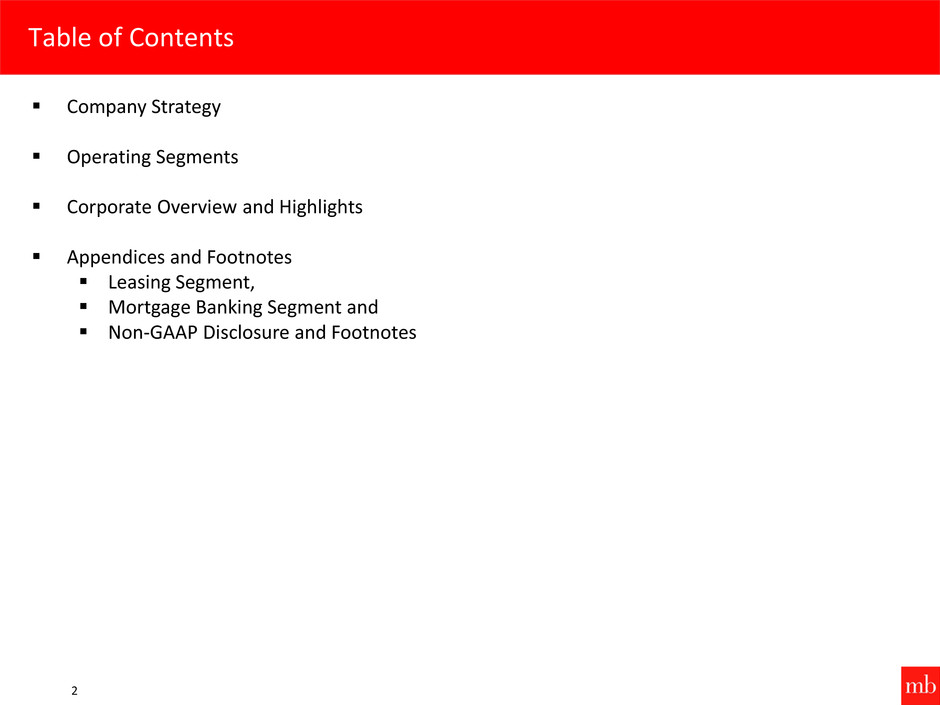
Table of Contents
2
Company Strategy
Operating Segments
Corporate Overview and Highlights
Appendices and Footnotes
Leasing Segment,
Mortgage Banking Segment and
Non-GAAP Disclosure and Footnotes
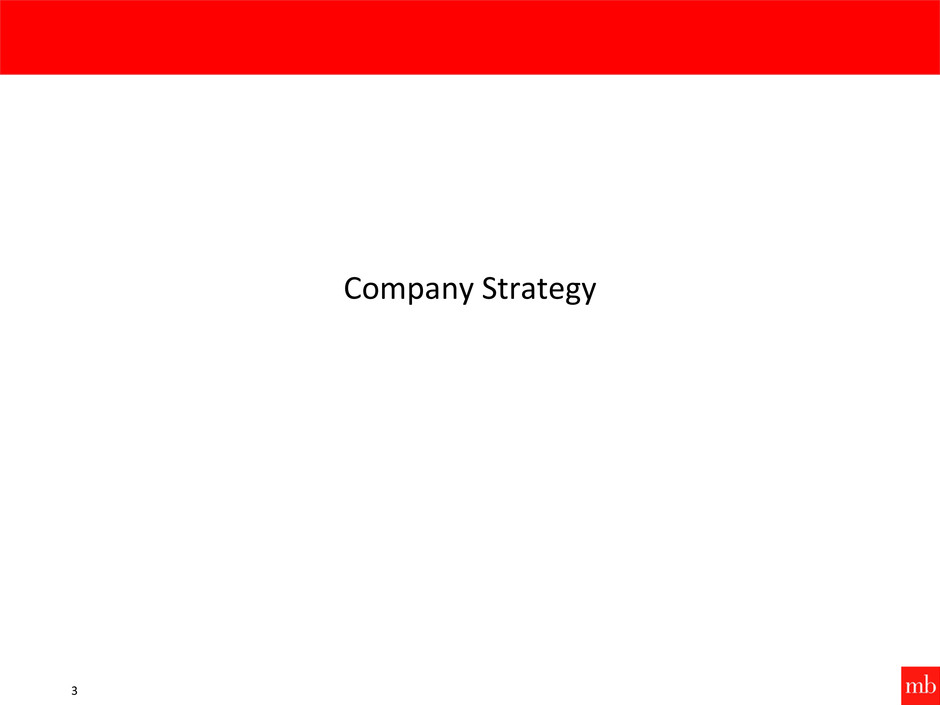
Company Strategy
3
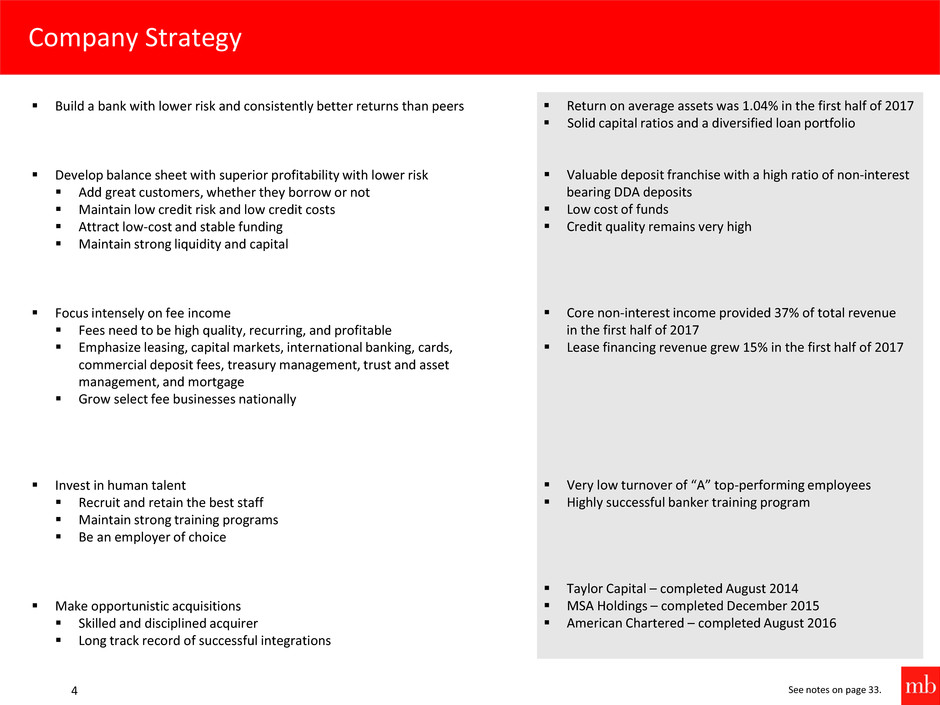
Return on average assets was 1.04% in the first half of 2017
Solid capital ratios and a diversified loan portfolio
Valuable deposit franchise with a high ratio of non-interest
bearing DDA deposits
Low cost of funds
Credit quality remains very high
Core non-interest income provided 37% of total revenue
in the first half of 2017
Lease financing revenue grew 15% in the first half of 2017
Very low turnover of “A” top-performing employees
Highly successful banker training program
Taylor Capital – completed August 2014
MSA Holdings – completed December 2015
American Chartered – completed August 2016
Company Strategy
4
Build a bank with lower risk and consistently better returns than peers
Develop balance sheet with superior profitability with lower risk
Add great customers, whether they borrow or not
Maintain low credit risk and low credit costs
Attract low-cost and stable funding
Maintain strong liquidity and capital
Focus intensely on fee income
Fees need to be high quality, recurring, and profitable
Emphasize leasing, capital markets, international banking, cards,
commercial deposit fees, treasury management, trust and asset
management, and mortgage
Grow select fee businesses nationally
Invest in human talent
Recruit and retain the best staff
Maintain strong training programs
Be an employer of choice
Make opportunistic acquisitions
Skilled and disciplined acquirer
Long track record of successful integrations
See notes on page 33.

Operating Segments
5
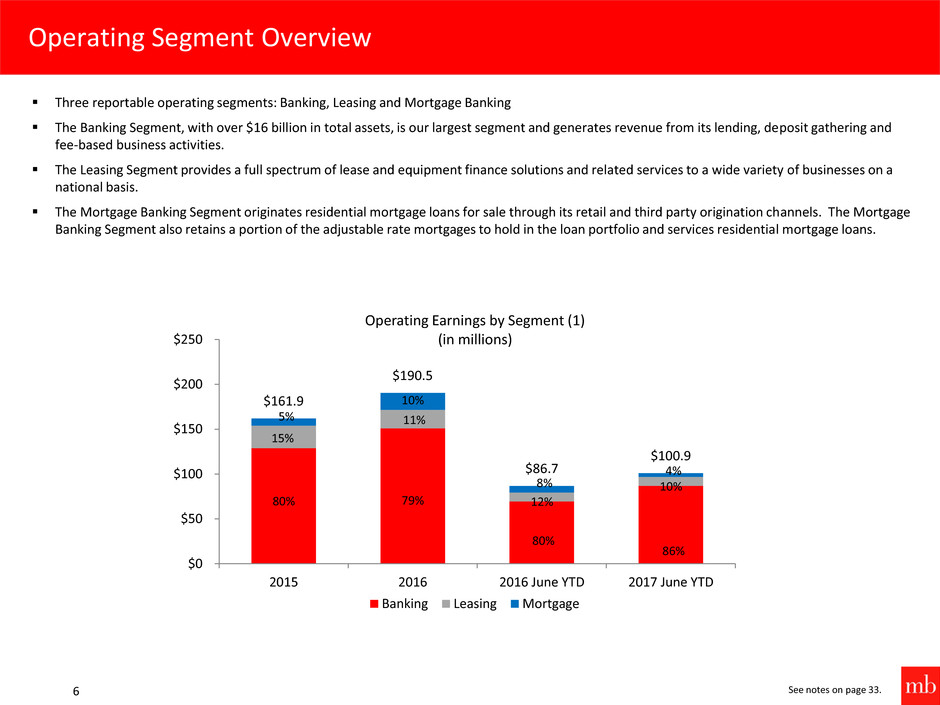
Operating Segment Overview
6
Three reportable operating segments: Banking, Leasing and Mortgage Banking
The Banking Segment, with over $16 billion in total assets, is our largest segment and generates revenue from its lending, deposit gathering and
fee-based business activities.
The Leasing Segment provides a full spectrum of lease and equipment finance solutions and related services to a wide variety of businesses on a
national basis.
The Mortgage Banking Segment originates residential mortgage loans for sale through its retail and third party origination channels. The Mortgage
Banking Segment also retains a portion of the adjustable rate mortgages to hold in the loan portfolio and services residential mortgage loans.
See notes on page 33.
$161.9
$190.5
$86.7
$100.9
80% 79%
80%
86%
15%
11%
12%
10%
5%
10%
8%
4%
0%
20%
40%
60%
80%
100%$0
$50
$100
$150
$200
$250
2015 2016 2016 June YTD 2017 June YTD
Operating Earnings by Segment (1)
(in millions)
Banking Leasing Mortgage

Banking Segment
7
Retail
Provides about 40% of deposits for the banking segment
High percentage of low-cost funding with a low reliance on CDs
Focuses on small businesses in our market and individuals that live or work near our
banking centers
Key fee initiatives include card services and treasury management services for
business banking customers
Wealth Management
Provides private banking, trust, investment management and retirement plan
services through a team of experienced advisors
Specializes in serving business owners, high-net worth families, foundations, and
endowments
Focuses on asset management, low-cost deposits, and private banking services
Manages and advises on more than $7.8 billion of client assets through trust and
asset management and subsidiaries (Cedar Hill Associates, LLC and MSA Holdings,
LLC)
Commercial Banking
Provides lending, depository and fee-based capital markets and international banking
services to middle-market companies with revenues from $2 million to $500 million
“Relationship banking” culture; experienced calling officers
Commercial and industrial and commercial real estate loan portfolio – terms
generally range from 1 to 5 years, with typical loan sizes between $3-30 million, and
approximately 76% have a floating rate of interest indexed to LIBOR or Prime
Expanding into specialized commercial areas such as healthcare and financial services
Note: Business line financial data as of June 30, 2017
Lease Banking
Provides discounted lease loans and other banking services to lessors located
throughout the country; these services include working capital loans, warehouse
loans, and equity investments in leases
Lease Banking has nearly $2.0 billion in loans outstanding
Lease loans are underwritten primarily on the creditworthiness of the lessee
Lessees include mostly investment grade “Fortune 1000” companies located
throughout the U.S. and large middle-market companies
Asset Based Lending
Through 17 sales offices in the U.S. and Canada targets national middle-market
companies, including manufacturers, distributors, and select service companies with
sales from $25 million to $500 million, has borrowers in 33 states
Deal flow via marketing efforts and relationships with private equity firms, mezzanine
and second lien capital providers, investment banks, consultants and other trusted
advisors
Asset based and hybrid ABL cash flow loans from $5 million to $50 million
Over $900 million of loans currently outstanding and $1.3 billion in commitments
Treasury Management
Focuses on providing high quality and recurring collection and payment solutions to
commercial and business banking customers as well as strategic industry niches
Expanding nationally where we have distinguishable expertise and scalability
Broad suite of customizable services including data reporting, payment and collection
automation, payment system access, and fraud/risk mitigation tools
See notes on page 33.
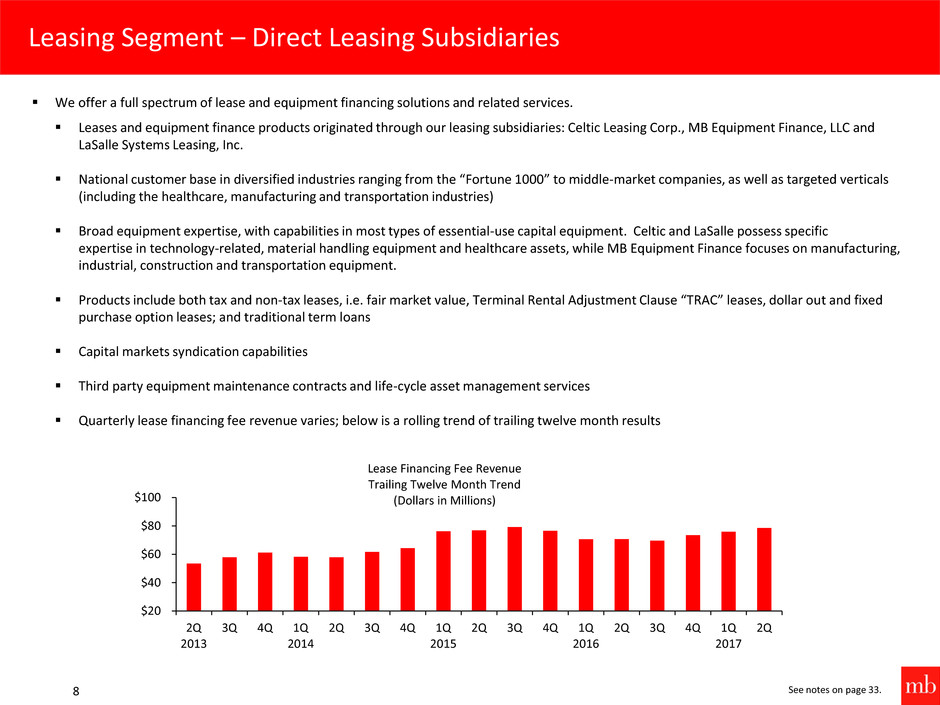
Leasing Segment – Direct Leasing Subsidiaries
8
$20
$40
$60
$80
$100
2Q
2013
3Q 4Q 1Q
2014
2Q 3Q 4Q 1Q
2015
2Q 3Q 4Q 1Q
2016
2Q 3Q 4Q 1Q
2017
2Q
Lease Financing Fee Revenue
Trailing Twelve Month Trend
(Dollars in Millions)
We offer a full spectrum of lease and equipment financing solutions and related services.
Leases and equipment finance products originated through our leasing subsidiaries: Celtic Leasing Corp., MB Equipment Finance, LLC and
LaSalle Systems Leasing, Inc.
National customer base in diversified industries ranging from the “Fortune 1000” to middle-market companies, as well as targeted verticals
(including the healthcare, manufacturing and transportation industries)
Broad equipment expertise, with capabilities in most types of essential-use capital equipment. Celtic and LaSalle possess specific
expertise in technology-related, material handling equipment and healthcare assets, while MB Equipment Finance focuses on manufacturing,
industrial, construction and transportation equipment.
Products include both tax and non-tax leases, i.e. fair market value, Terminal Rental Adjustment Clause “TRAC” leases, dollar out and fixed
purchase option leases; and traditional term loans
Capital markets syndication capabilities
Third party equipment maintenance contracts and life-cycle asset management services
Quarterly lease financing fee revenue varies; below is a rolling trend of trailing twelve month results
See notes on page 33.
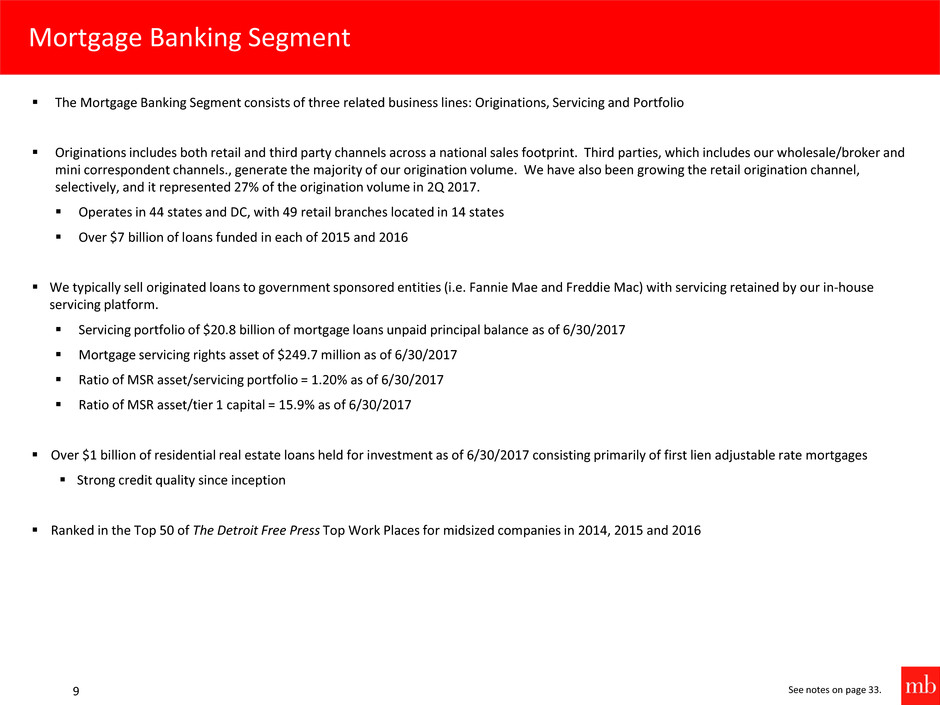
Mortgage Banking Segment
9
The Mortgage Banking Segment consists of three related business lines: Originations, Servicing and Portfolio
Originations includes both retail and third party channels across a national sales footprint. Third parties, which includes our wholesale/broker and
mini correspondent channels., generate the majority of our origination volume. We have also been growing the retail origination channel,
selectively, and it represented 27% of the origination volume in 2Q 2017.
Operates in 44 states and DC, with 49 retail branches located in 14 states
Over $7 billion of loans funded in each of 2015 and 2016
We typically sell originated loans to government sponsored entities (i.e. Fannie Mae and Freddie Mac) with servicing retained by our in-house
servicing platform.
Servicing portfolio of $20.8 billion of mortgage loans unpaid principal balance as of 6/30/2017
Mortgage servicing rights asset of $249.7 million as of 6/30/2017
Ratio of MSR asset/servicing portfolio = 1.20% as of 6/30/2017
Ratio of MSR asset/tier 1 capital = 15.9% as of 6/30/2017
Over $1 billion of residential real estate loans held for investment as of 6/30/2017 consisting primarily of first lien adjustable rate mortgages
Strong credit quality since inception
Ranked in the Top 50 of The Detroit Free Press Top Work Places for midsized companies in 2014, 2015 and 2016
See notes on page 33.

Corporate Overview and Highlights
10

Loan Growth Components – Organic and Acquisitions
12/31/2013
Percent of
Total 6/30/2017
Percent of
Total CAGR
Commercia l $ 1,282 23% $ 4,703 35% 45%
Commercia l col latera l ized by ass ignment of lease payments (lease loans) 1,494 27% 2,077 15% 10%
Commercia l real estate (2) 1,648 30% 3,883 29% 28%
Construction real estate 141 3% 449 3% 39%
Res identia l real estate 314 6% 1,411 11% 53%
Other consumer 598 11% 942 7% 14%
Gross loans , excluding HFS and PCI loans $ 5,477 100% $ 13,465 100% 29%
Loans
(Dol lars in mi l l ions)
11 See notes on page 33.
$0
$4,000
$8,000
$12,000
$16,000
4Q 1Q
2014
2Q 3Q 4Q 1Q
2015
2Q 3Q 4Q 1Q
2016
2Q 3Q 4Q 1Q
2017
2Q
Period End Loans (excluding HFS and PCI Loans)
Acquisitions
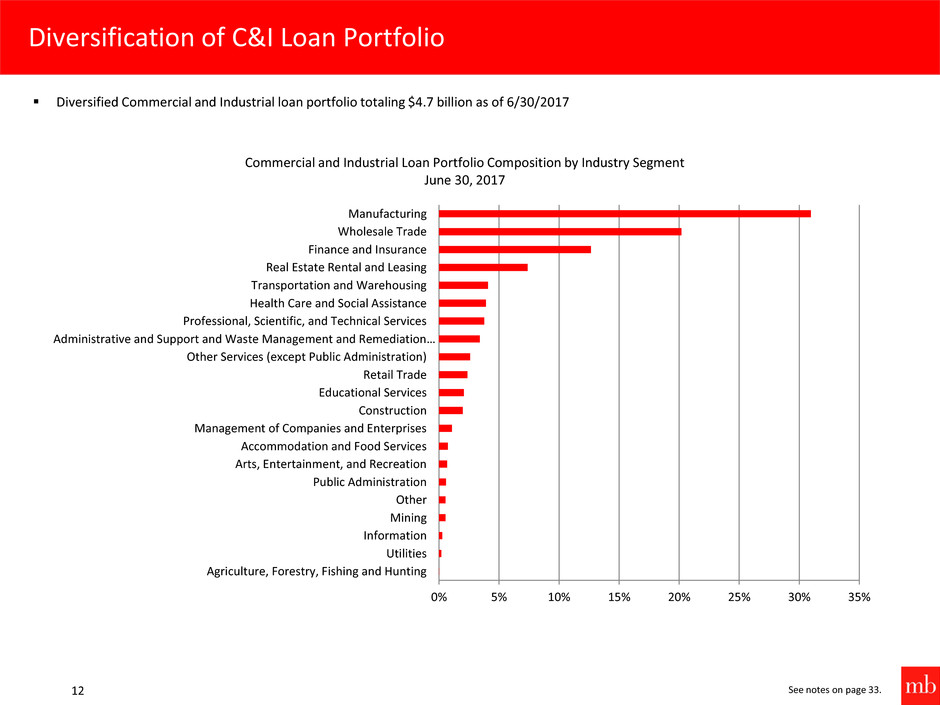
Diversification of C&I Loan Portfolio
12 See notes on page 33.
0% 5% 10% 15% 20% 25% 30% 35%
Agriculture, Forestry, Fishing and Hunting
Utilities
Information
Mining
Other
Public Administration
Arts, Entertainment, and Recreation
Accommodation and Food Services
Management of Companies and Enterprises
Construction
Educational Services
Retail Trade
Other Services (except Public Administration)
Administrative and Support and Waste Management and Remediation…
Professional, Scientific, and Technical Services
Health Care and Social Assistance
Transportation and Warehousing
Real Estate Rental and Leasing
Finance and Insurance
Wholesale Trade
Manufacturing
Commercial and Industrial Loan Portfolio Composition by Industry Segment
June 30, 2017
Diversified Commercial and Industrial loan portfolio totaling $4.7 billion as of 6/30/2017
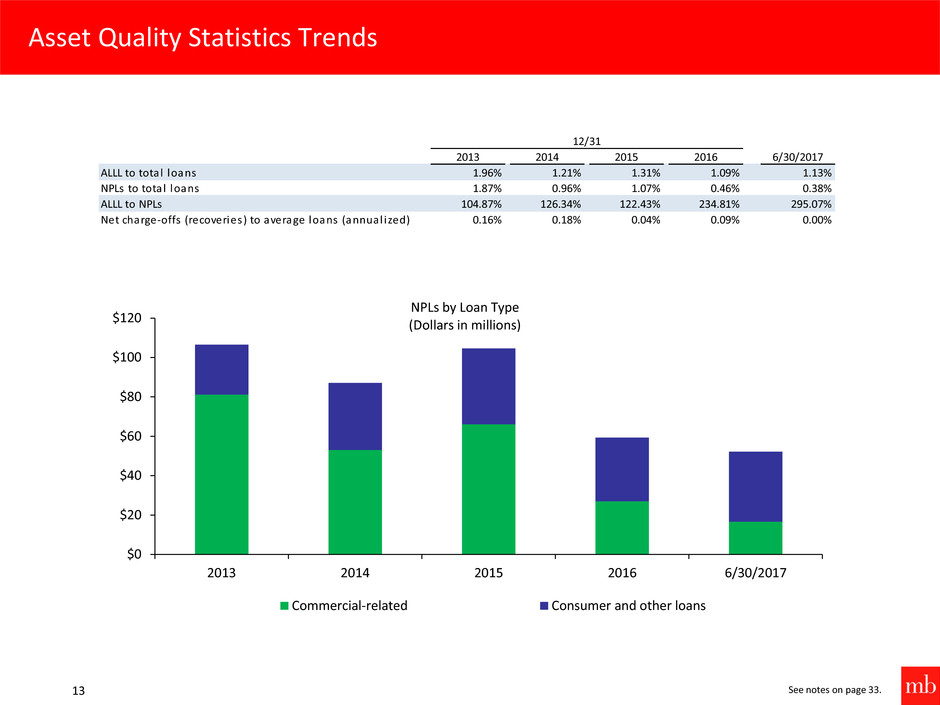
Asset Quality Statistics Trends
13
2013 2014 2015 2016 6/30/2017
ALLL to total loans 1.96% 1.21% 1.31% 1.09% 1.13%
NPLs to total loans 1.87 0.96 1.07 0.46 0.38
ALLL to NPLs 104.87% 126.34% 122.43% 234.81% 295.07%
Net charge-offs (recoveries) to average loans (annual ized) 0.16 0.18 0.04 0.09 0.00
12/31
See notes on page 33.
$0
$20
$40
$60
$80
$100
$120
2013 2014 2015 2016 6/30/2017
NPLs by Loan Type
(Dollars in millions)
Commercial-related Consumer and other loans
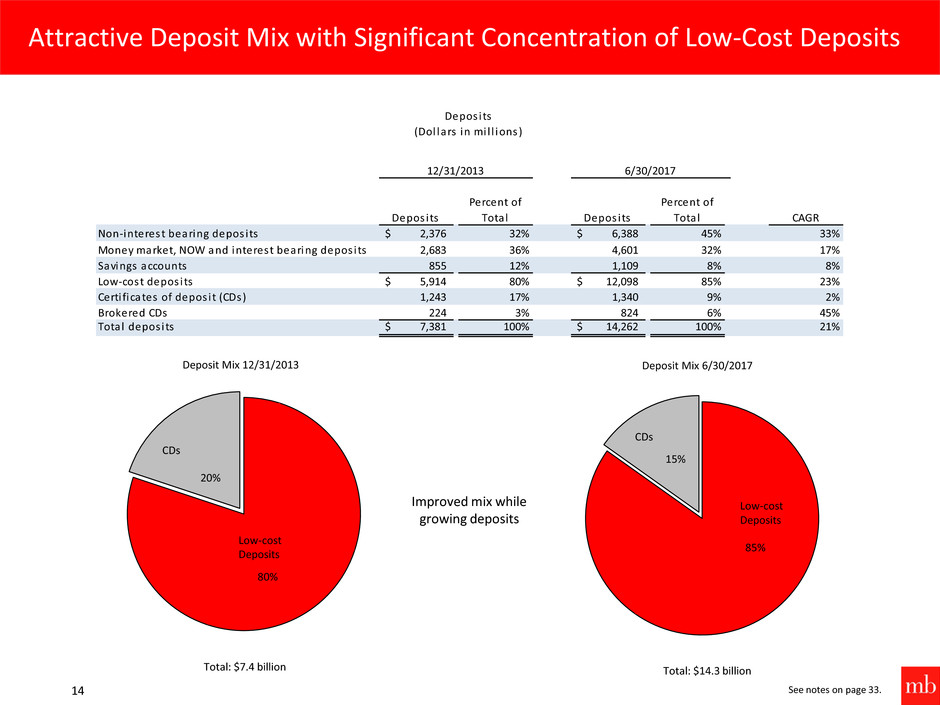
85%
15%
Low-cost
Deposits
CDs
Attractive Deposit Mix with Significant Concentration of Low-Cost Deposits
Deposit Mix 6/30/2017
Total: $14.3 billion
80%
20%
Low-cost
Deposits
CDs
Deposit Mix 12/31/2013
Total: $7.4 billion
Improved mix while
growing deposits
Depos its
Percent of
Total Depos its
Percent of
Total CAGR
Non-interest bearing depos its $ 2,376 32% $ 6,388 45% 33%
Money market, NOW and interest bearing depos its 2,683 36% 4,601 32% 17%
Savings accounts 855 12% 1,109 8% 8%
Low-cost depos its $ 5,914 80% $ 12,098 85% 23%
Certi ficates of depos it (CDs) 1,243 17% 1,340 9% 2%
Brokered CDs 224 3% 824 6% 45%
Total depos its $ 7,381 100% $ 14,262 100% 21%
Depos its
(Dol lars in mi l l ions)
12/31/2013 6/30/2017
14 See notes on page 33.
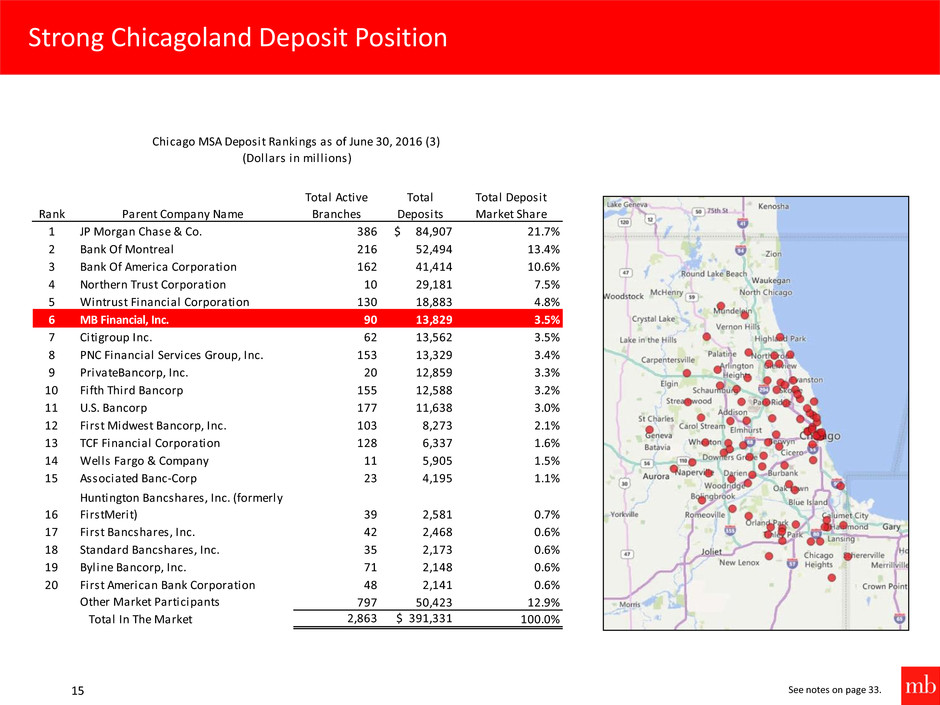
Strong Chicagoland Deposit Position
15
Rank Parent Company Name
Total Active
Branches
Total
Deposits
Total Deposit
Market Share
1 JP Morgan Chase & Co. 386 $ 84,907 21.7%
2 Bank Of Montreal 216 52,494 13.4%
3 Bank Of America Corporation 162 41,414 10.6%
4 Northern Trust Corporation 10 29,181 7.5%
5 Wintrust Financial Corporation 130 18,883 4.8%
6 MB Financial, Inc. 90 13,829 3.5%
7 Citigroup Inc. 62 13,562 3.5%
8 PNC Financial Services Group, Inc. 153 13,329 3.4%
9 PrivateBancorp, Inc. 20 12,859 3.3%
10 Fifth Third Bancorp 155 12,588 3.2%
11 U.S. Bancorp 177 11,638 3.0%
12 First Midwest Bancorp, Inc. 103 8,273 2.1%
13 TCF Financial Corporation 128 6,337 1.6%
14 Wells Fargo & Company 11 5,905 1.5%
15 Associated Banc-Corp 23 4,195 1.1%
16
Huntington Bancshares, Inc. (formerly
FirstMerit) 39 2,581 0.7%
17 First Bancshares, Inc. 42 2,468 0.6%
18 Standard Bancshares, Inc. 35 2,173 0.6%
19 Byline Bancorp, Inc. 71 2,148 0.6%
20 First American Bank Corporation 48 2,141 0.6%
Other Market Participants 797 50,423 12.9%
Total In The Market 2,863 $ 391,331 100.0%
Chicago MSA Deposit Rankings as of June 30, 2016 (3)
(Dollars in mill ions)
See notes on page 33.

Stockholder Focus
16
$0.00
$0.05
$0.10
$0.15
$0.20
$0.25
2Q
2013
3Q 4Q 1Q
2014
2Q 3Q 4Q 1Q
2015
2Q 3Q 4Q 1Q
2016
2Q 3Q 4Q 1Q
2017
2Q
Quarterly Dividend per Common Share
Listed securities: Common (NASDAQ: MBFI) and 8.00% Series A Preferred Stock (NASDAQ: MBFIP)
$3.5 billion market capitalization as of August 2, 2017
MBFI common shares are included in several major indexes (4)
Approximately 84 million common shares outstanding; large institutional and mutual fund ownership
Increased quarterly common dividend to $0.21 per share in 2Q 2017
In the third and fourth quarters of 2015 repurchased approximately 1.6 million common shares for $50 million completing a previously
announced authorization
See notes on page 33.
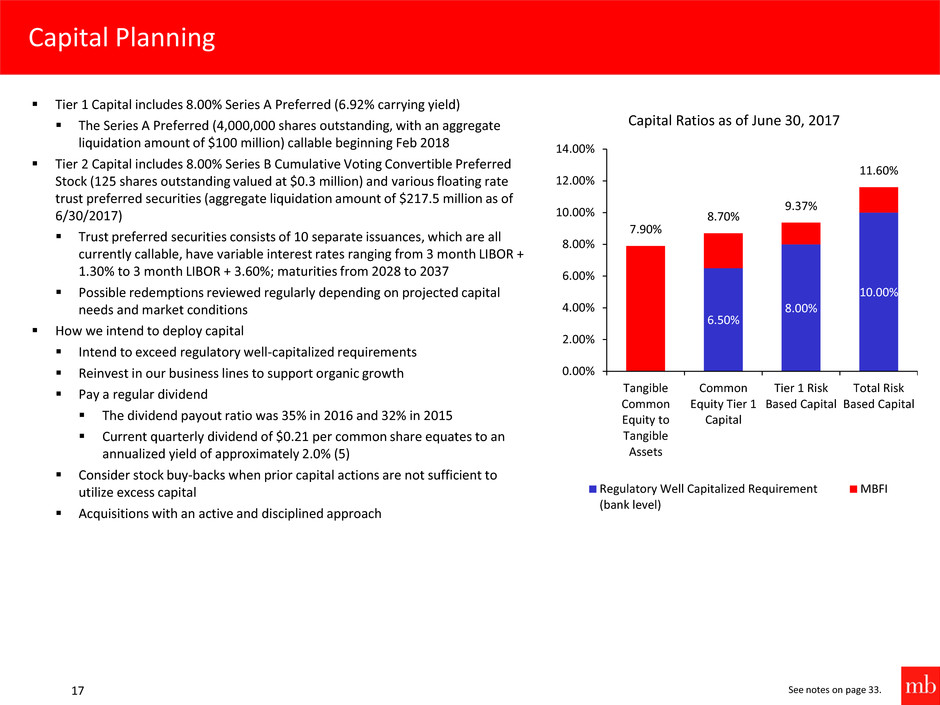
Capital Planning
17
6.50%
8.00%
10.00%
7.90%
8.70%
9.37%
11.60%
0.00%
2.00%
4.00%
6.00%
8.00%
10.00%
12.00%
14.00%
Tangible
Common
Equity to
Tangible
Assets
Common
Equity Tier 1
Capital
Tier 1 Risk
Based Capital
Total Risk
Based Capital
Capital Ratios as of June 30, 2017
Regulatory Well Capitalized Requirement
(bank level)
MBFI
Tier 1 Capital includes 8.00% Series A Preferred (6.92% carrying yield)
The Series A Preferred (4,000,000 shares outstanding, with an aggregate
liquidation amount of $100 million) callable beginning Feb 2018
Tier 2 Capital includes 8.00% Series B Cumulative Voting Convertible Preferred
Stock (125 shares outstanding valued at $0.3 million) and various floating rate
trust preferred securities (aggregate liquidation amount of $217.5 million as of
6/30/2017)
Trust preferred securities consists of 10 separate issuances, which are all
currently callable, have variable interest rates ranging from 3 month LIBOR +
1.30% to 3 month LIBOR + 3.60%; maturities from 2028 to 2037
Possible redemptions reviewed regularly depending on projected capital
needs and market conditions
How we intend to deploy capital
Intend to exceed regulatory well-capitalized requirements
Reinvest in our business lines to support organic growth
Pay a regular dividend
The dividend payout ratio was 35% in 2016 and 32% in 2015
Current quarterly dividend of $0.21 per common share equates to an
annualized yield of approximately 2.0% (5)
Consider stock buy-backs when prior capital actions are not sufficient to
utilize excess capital
Acquisitions with an active and disciplined approach
See notes on page 33.
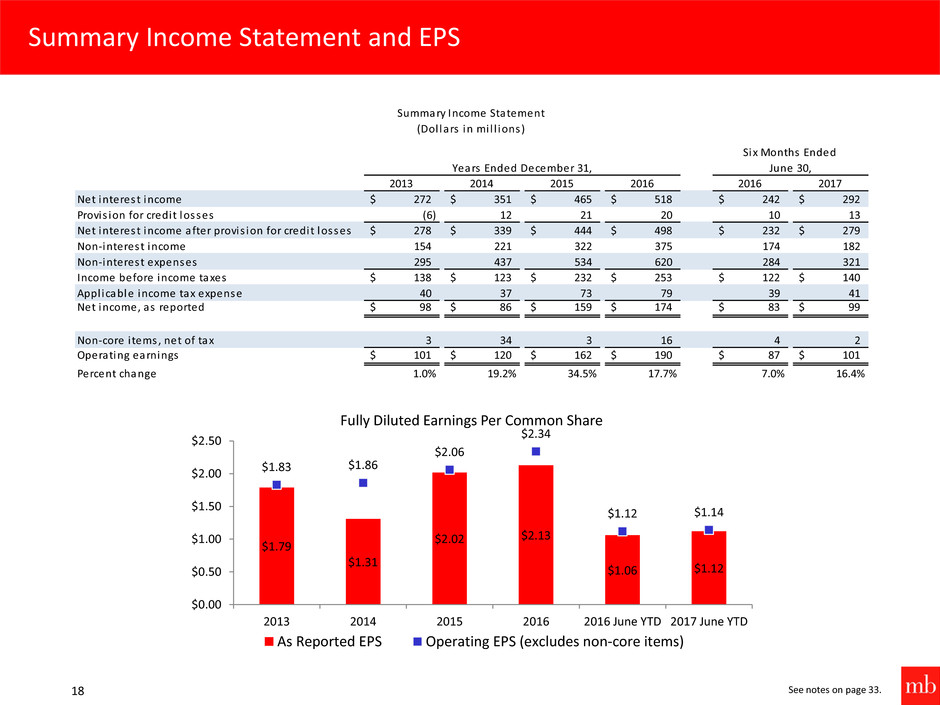
2013 2014 2015 2016 2016 2017
Net interest income $ 272 $ 351 $ 465 $ 518 $ 242 $ 292
Provis ion for credit losses (6) 12 21 20 10 13
Net interest income after provis ion for credit losses $ 278 $ 339 $ 444 $ 498 $ 232 $ 279
Non-interest income 154 221 322 375 174 182
Non-interest expenses 295 437 534 620 284 321
Income before income taxes $ 138 $ 123 $ 232 $ 253 $ 122 $ 140
Appl icable income tax expense 40 37 73 79 39 41
Net income, as reported $ 98 $ 86 $ 159 $ 174 $ 83 $ 99
Non-core i tems, net of tax 3 34 3 16 4 2
Operating earnings $ 101 $ 120 $ 162 $ 190 $ 87 $ 101
Percent change 1.0% 19.2% 34.5% 17.7% 7.0% 16.4%
Summary Income Statement
(Dol lars in mi l l ions)
Years Ended December 31,
Six Months Ended
June 30,
Summary Income Statement and EPS
18 See notes on page 33.
$1.79
$1.31
$2.02 $2.13
$1.06 $1.12
$1.83 $1.86
$2.06
$2.34
$1.12 $1.14
$0.00
$0.50
$1.00
$1.50
$2.00
$2.50
2013 2014 2015 2016 2016 June YTD 2017 June YTD
Fully Diluted Earnings Per Common Share
As Reported EPS Operating EPS (excludes non-core items)
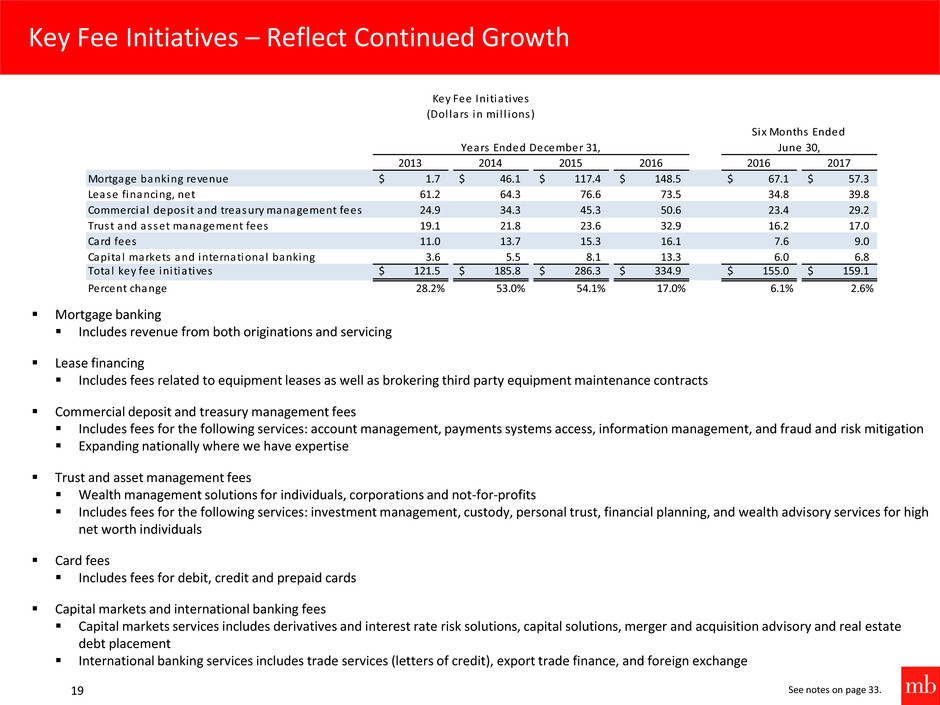
Key Fee Initiatives – Reflect Continued Growth
19
2013 2014 2015 2016 2016 2017
Mortgage banking revenue $ 1.7 $ 46.1 $ 117.4 $ 148.5 $ 67.1 $ 57.3
Lease financing, net 61.2 64.3 76.6 73.5 34.8 39.8
Commercia l depos it and treasury management fees 24.9 34.3 45.3 50.6 23.4 29.2
Trust and asset management fees 19.1 21.8 23.6 32.9 16.2 17.0
Card fees 11.0 13.7 15.3 16.1 7.6 9.0
Capita l markets and international banking 3.6 5.5 8.1 13.3 6.0 6.8
Total key fee ini tiatives $ 121.5 $ 185.8 $ 286.3 $ 334.9 $ 155.0 $ 159.1
Percent change 28.2% 53.0% 54.1% 17.0% 6.1% 2.6%
Years Ended December 31,
Six Months Ended
June 30,
Key Fee Ini tiatives
(Dol lars in mi l l ions)
Mortgage banking
Includes revenue from both originations and servicing
Lease financing
Includes fees related to equipment leases as well as brokering third party equipment maintenance contracts
Commercial deposit and treasury management fees
Includes fees for the following services: account management, payments systems access, information management, and fraud and risk mitigation
Expanding nationally where we have expertise
Trust and asset management fees
Wealth management solutions for individuals, corporations and not-for-profits
Includes fees for the following services: investment management, custody, personal trust, financial planning, and wealth advisory services for high
net worth individuals
Card fees
Includes fees for debit, credit and prepaid cards
Capital markets and international banking fees
Capital markets services includes derivatives and interest rate risk solutions, capital solutions, merger and acquisition advisory and real estate
debt placement
International banking services includes trade services (letters of credit), export trade finance, and foreign exchange
See notes on page 33.
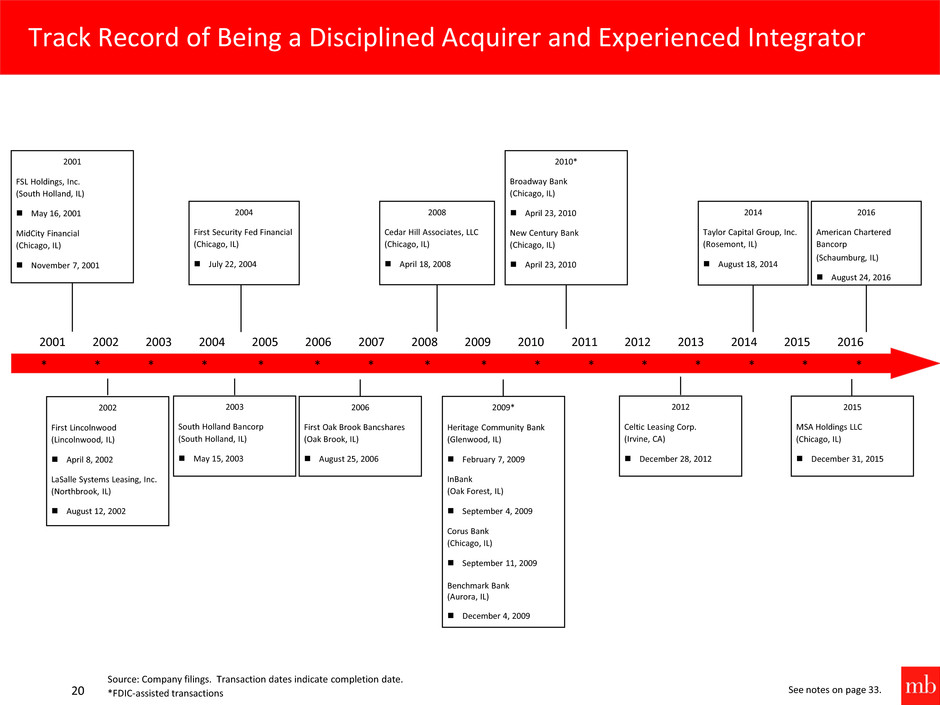
2002
First Lincolnwood
(Lincolnwood, IL)
April 8, 2002
LaSalle Systems Leasing, Inc.
(Northbrook, IL)
August 12, 2002
2006
First Oak Brook Bancshares
(Oak Brook, IL)
August 25, 2006
Track Record of Being a Disciplined Acquirer and Experienced Integrator
2012
Celtic Leasing Corp.
(Irvine, CA)
December 28, 2012
2001 2002 2003 2004 2005 2006 2007 2008 2009 2010 2011 2012 2013 2014 2015 2016
* * * * * * * * * * * * * * * *
2008
Cedar Hill Associates, LLC
(Chicago, IL)
April 18, 2008
2010*
Broadway Bank
(Chicago, IL)
April 23, 2010
New Century Bank
(Chicago, IL)
April 23, 2010
2014
Taylor Capital Group, Inc.
(Rosemont, IL)
August 18, 2014
Source: Company filings. Transaction dates indicate completion date.
*FDIC-assisted transactions 20
2004
First Security Fed Financial
(Chicago, IL)
July 22, 2004
2001
FSL Holdings, Inc.
(South Holland, IL)
May 16, 2001
MidCity Financial
(Chicago, IL)
November 7, 2001
2015
MSA Holdings LLC
(Chicago, IL)
December 31, 2015
2009*
Heritage Community Bank
(Glenwood, IL)
February 7, 2009
InBank
(Oak Forest, IL)
September 4, 2009
Corus Bank
(Chicago, IL)
September 11, 2009
Benchmark Bank
(Aurora, IL)
December 4, 2009
See notes on page 33.
2003
South Holland Bancorp
(South Holland, IL)
May 15, 2003
2016
American Chartered
Bancorp
(Schaumburg, IL)
August 24, 2016

Comparison of key earnings components to 1Q 2017
Provision for credit losses increased $6.0 million as a result of strong loan growth
Core non-interest income decreased 1.6% to $89.2 million primarily due to lower promotional leasing income and residual gains on leases
Core non-interest expenses, excluding the volume-driven commission expenses, increased 1.5% to $148.0 million primarily due to annual
pay increases and loan related expenses
Overall operating earnings decreased 10.2% to $47.8 million
Total loans, excluding purchased credit-impaired loans, grew $675.4 million or 5.3% (21.2% annualized) in 2Q 2017 across multiple categories
Total deposits increased 1.9% in 2Q 2017 due mostly to growth in non-interest bearing deposits
Credit quality metrics
Ratio of non-performing loans to total loans was 0.38% at 6/30/2017 unchanged from 3/31/2017
Annualized net loan charge-offs (recoveries) to average loans was (0.00%) for 2Q 2017 as compared to (0.03%) for 1Q 2017
Recent Company Highlights – 2Q 2017
21 See notes on page 33.
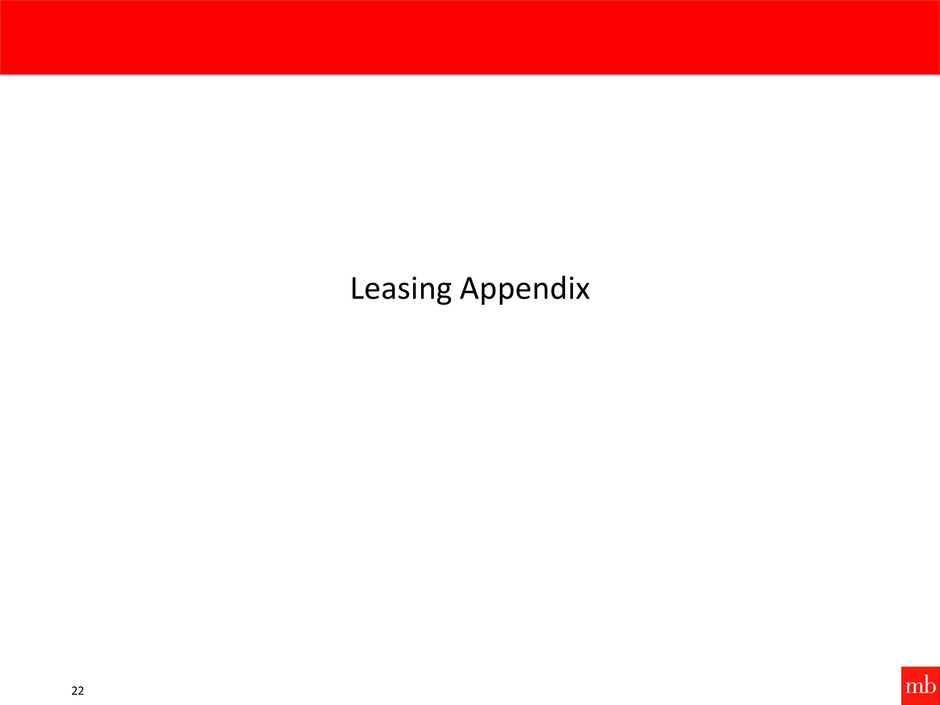
Leasing Appendix
22

Lease Banking and Direct Leasing Subsidiaries
23
Business
Corporate
Headquarters
Rosemont, IL Rosemont, IL Irvine, CA Hunt Valley, MD
General Business
Description
Lessor funding source,
principally providing non-
recourse debt to independent
leasing companies, captives
and institutional vendor
finance companies
Technology solutions and
leasing company focused
principally on leasing and life-
cycle asset management, with a
direct-to-end-user sales
approach
General equipment leasing and
finance company focused on
small-to-mid ticket, direct
origination utilizing a call center
approach
Traditional bank equipment
leasing and finance company
focused on mid-to-large ticket
direct origination, as well as
indirect institutional originations
and syndications
Target Audience
(National)
Independent leasing
companies
Middle market companies and
autonomous divisions of large
companies
Middle market
Middle market to large
companies
Equipment
Specialization
Technology
Healthcare
Material Handling
Technology
Healthcare
Material Handling
Technology
Healthcare
Transportation
Manufacturing
Marine
Distribution equipment
Product
Specialization
Non-recourse debt
Principally fair market value
(FMV) lease products, reseller
of Cisco maintenance
FMV, purchase renewal option
and dollar out leases
FMV, early buy out, TRAC,
synthetic and dollar out leases
and traditional loans
Total Assets
(as of 6/30/2017)
$2.1 Billion $0.3 Billion $0.3 Billion $0.5 Billion
Lease Banking
Leasing Segment –
Direct Leasing Subsidiaries
See notes on page 33.
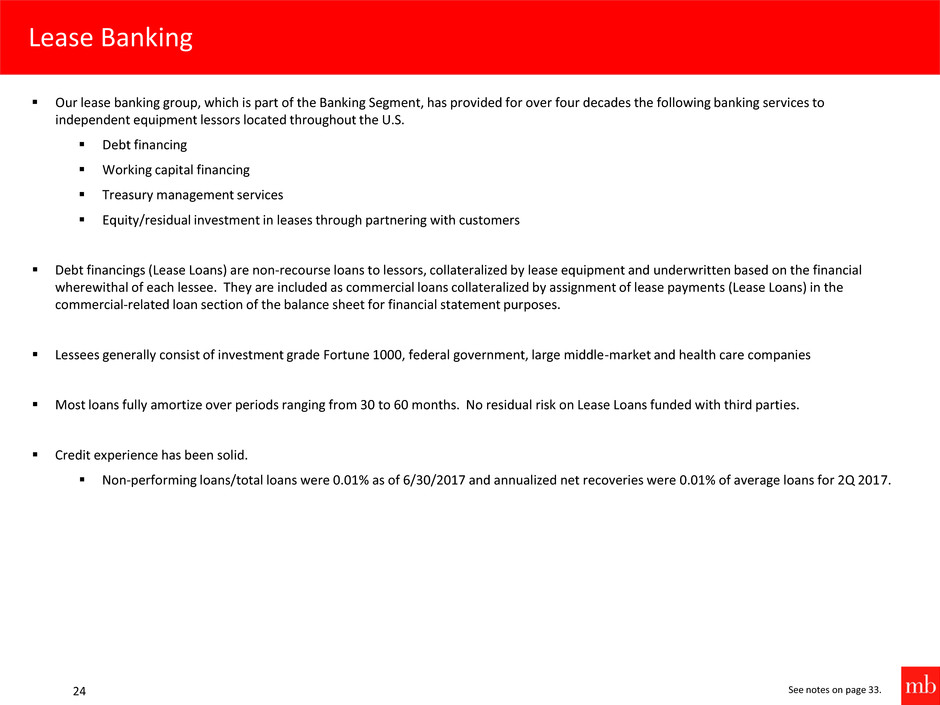
Lease Banking
24
Our lease banking group, which is part of the Banking Segment, has provided for over four decades the following banking services to
independent equipment lessors located throughout the U.S.
Debt financing
Working capital financing
Treasury management services
Equity/residual investment in leases through partnering with customers
Debt financings (Lease Loans) are non-recourse loans to lessors, collateralized by lease equipment and underwritten based on the financial
wherewithal of each lessee. They are included as commercial loans collateralized by assignment of lease payments (Lease Loans) in the
commercial-related loan section of the balance sheet for financial statement purposes.
Lessees generally consist of investment grade Fortune 1000, federal government, large middle-market and health care companies
Most loans fully amortize over periods ranging from 30 to 60 months. No residual risk on Lease Loans funded with third parties.
Credit experience has been solid.
Non-performing loans/total loans were 0.01% as of 6/30/2017 and annualized net recoveries were 0.01% of average loans for 2Q 2017.
See notes on page 33.

Direct Leasing Subsidiaries
25
Leases are originated directly throughout the U.S. by our three leasing subsidiaries, LaSalle Solutions, Celtic Equipment Finance and MB Equipment
Finance, which together form the Leasing Segment in our earnings release. LaSalle and Celtic are customers of our Lease Banking group and
generally finance much of their equipment cost with internal debt. MB Equipment Finance funds 100% of its leases internally.
The lease portfolio is comprised of various types of equipment including information technology, healthcare, material handling, general
manufacturing distribution, and transportation equipment.
Lease income is recognized over the life of the lease so that at the end of lease term the residual amount approximates the fair market value of
the leased equipment
MB’s leasing subsidiaries offer a broad suite of lease products, which, at the end of a lease term, may permit the lease to be renewed/extended,
purchased, or the equipment may be returned and sold.
We also broker maintenance contracts provided by third party vendors to our customers covering equipment leased from MB as well as other
equipment owned or leased by our clients. Third party vendors are responsible for completing any maintenance covered by a maintenance
contract. Maintenance contract revenue is presented, net of the related cost of sales paid to third party vendors, as part of Lease Financing Fee
Income for financial statement purposes.
Balance sheet classification: Direct Finance and Leveraged Leases that transfer substantially all of the benefits and risk related to the equipment
ownership are grouped with Lease Loans in the loan section. By contrast, for Operating Leases, the underlying equipment at cost and net of
accumulated depreciation is reflected in Lease investments, net, which is part of other assets, and was $346 million at 6/30/2017.
Income statement classification: Interest income on Direct Finance and Leveraged Leases and accreted residual income on these leases are
included in Interest Income. By contrast, Lease Payments on Operating Leases plus accreted residual income on these leases less any depreciation
expense on the equipment are included in non-interest income Lease Financing Fee Income. Proceeds received as a result of lease renewals and
equipment sales less any residual investment in the lease results in a gain or loss that is also reflected in Lease Financing Fee Income.
See notes on page 33.
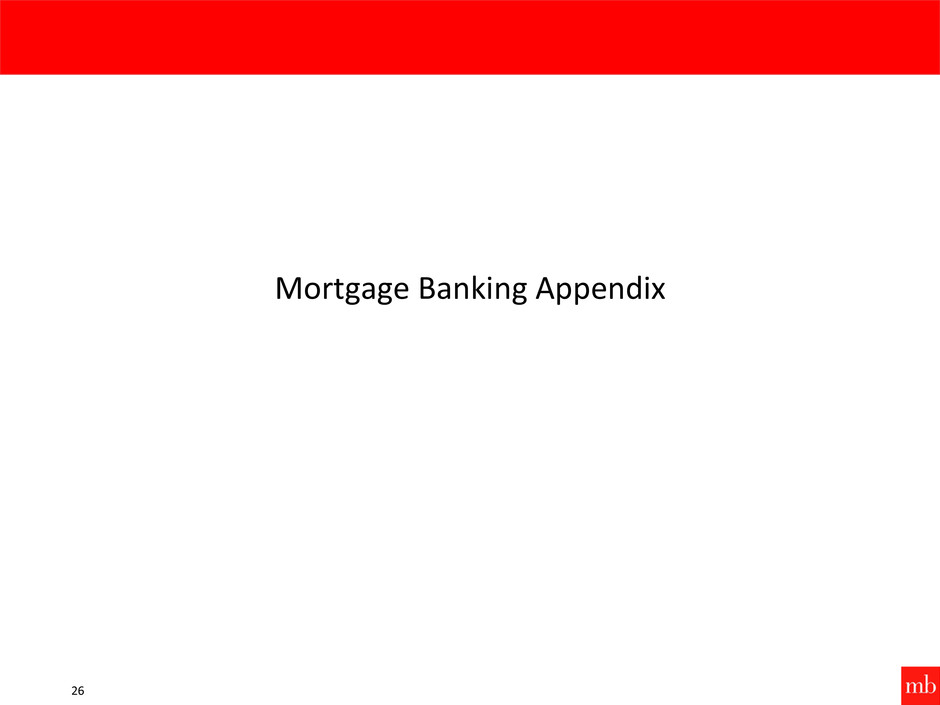
Mortgage Banking Appendix
26
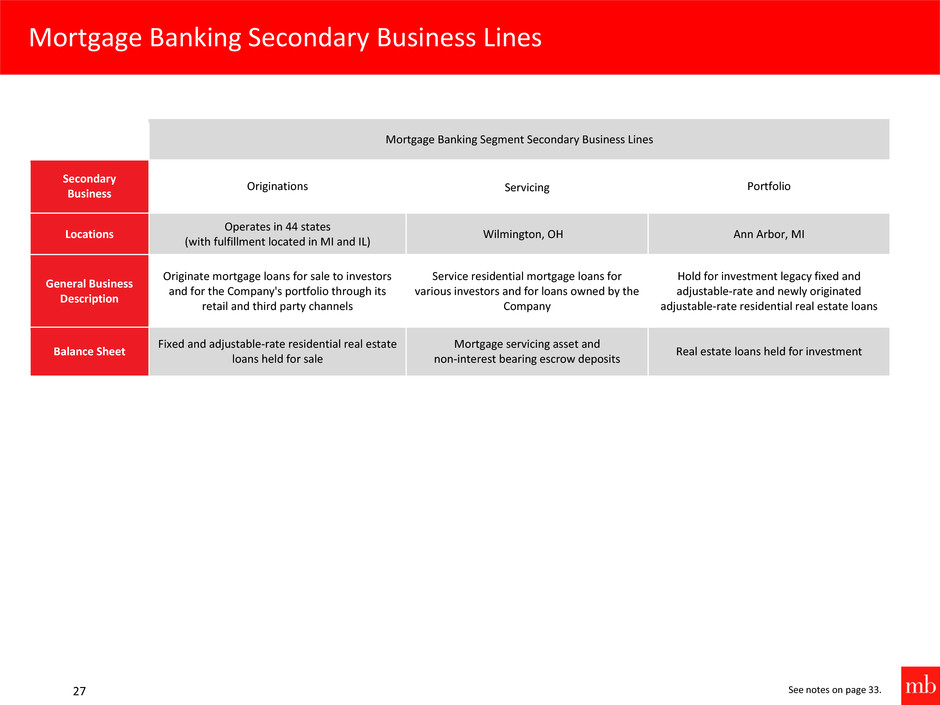
Mortgage Banking Secondary Business Lines
27
Mortgage Banking Segment Secondary Business Lines
Secondary
Business
Originations
Servicing Portfolio
Locations
Operates in 44 states
(with fulfillment located in MI and IL)
Wilmington, OH Ann Arbor, MI
General Business
Description
Originate mortgage loans for sale to investors
and for the Company's portfolio through its
retail and third party channels
Service residential mortgage loans for
various investors and for loans owned by the
Company
Hold for investment legacy fixed and
adjustable-rate and newly originated
adjustable-rate residential real estate loans
Balance Sheet
Fixed and adjustable-rate residential real estate
loans held for sale
Mortgage servicing asset and
non-interest bearing escrow deposits
Real estate loans held for investment
See notes on page 33.
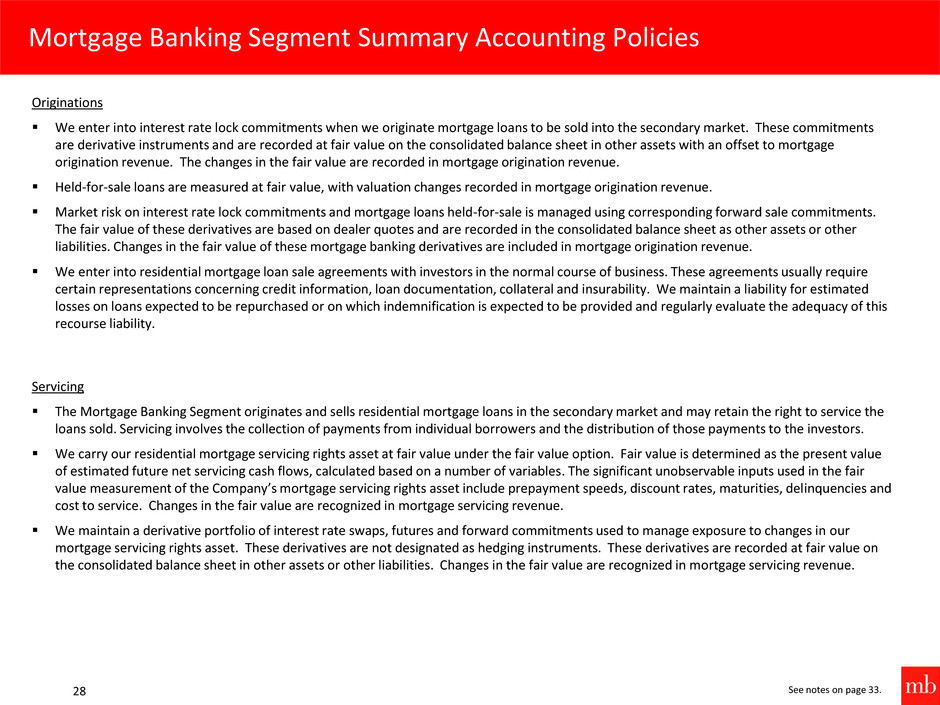
Mortgage Banking Segment Summary Accounting Policies
28
Originations
We enter into interest rate lock commitments when we originate mortgage loans to be sold into the secondary market. These commitments
are derivative instruments and are recorded at fair value on the consolidated balance sheet in other assets with an offset to mortgage
origination revenue. The changes in the fair value are recorded in mortgage origination revenue.
Held-for-sale loans are measured at fair value, with valuation changes recorded in mortgage origination revenue.
Market risk on interest rate lock commitments and mortgage loans held-for-sale is managed using corresponding forward sale commitments.
The fair value of these derivatives are based on dealer quotes and are recorded in the consolidated balance sheet as other assets or other
liabilities. Changes in the fair value of these mortgage banking derivatives are included in mortgage origination revenue.
We enter into residential mortgage loan sale agreements with investors in the normal course of business. These agreements usually require
certain representations concerning credit information, loan documentation, collateral and insurability. We maintain a liability for estimated
losses on loans expected to be repurchased or on which indemnification is expected to be provided and regularly evaluate the adequacy of this
recourse liability.
See notes on page 33.
Servicing
The Mortgage Banking Segment originates and sells residential mortgage loans in the secondary market and may retain the right to service the
loans sold. Servicing involves the collection of payments from individual borrowers and the distribution of those payments to the investors.
We carry our residential mortgage servicing rights asset at fair value under the fair value option. Fair value is determined as the present value
of estimated future net servicing cash flows, calculated based on a number of variables. The significant unobservable inputs used in the fair
value measurement of the Company’s mortgage servicing rights asset include prepayment speeds, discount rates, maturities, delinquencies and
cost to service. Changes in the fair value are recognized in mortgage servicing revenue.
We maintain a derivative portfolio of interest rate swaps, futures and forward commitments used to manage exposure to changes in our
mortgage servicing rights asset. These derivatives are not designated as hedging instruments. These derivatives are recorded at fair value on
the consolidated balance sheet in other assets or other liabilities. Changes in the fair value are recognized in mortgage servicing revenue.
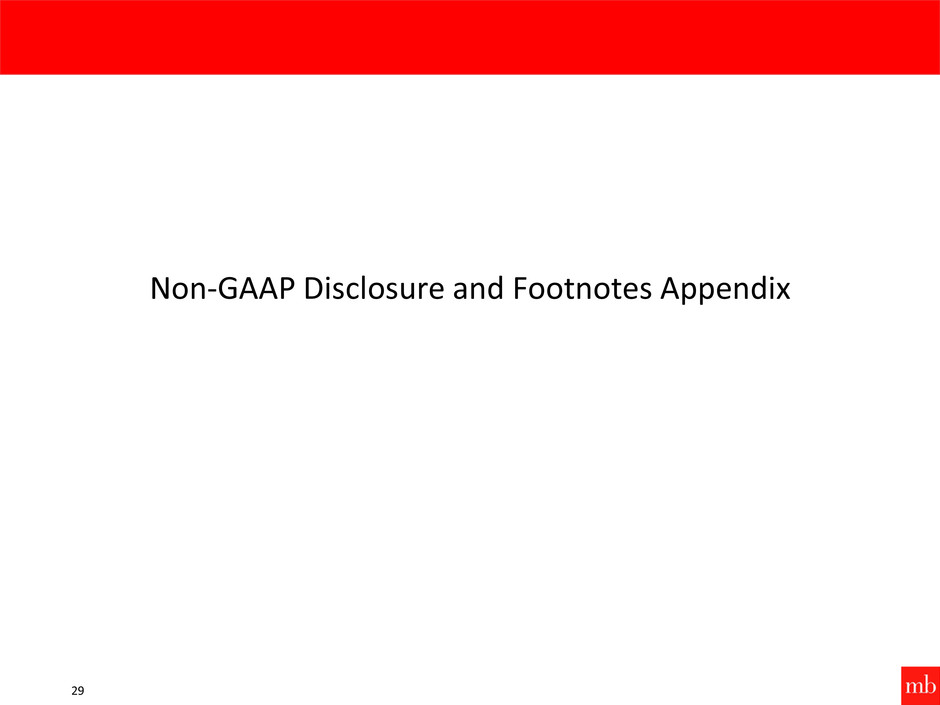
Non-GAAP Disclosure and Footnotes Appendix
29

Non-GAAP Disclosure Reconciliations
30
This presentation contains certain financial information determined by methods other than in accordance with accounting principles generally
accepted in the United States of America (GAAP). These measures include core (or operating) earnings, core non-interest income, core non-interest
income to revenues (with non-core items excluded from both core non-interest income and revenues and on a (“FTE”) fully tax equivalent basis), core
non-interest expense, net interest income on a FTE basis, net interest margin on a FTE basis, net interest margin on a FTE basis excluding acquisition
accounting discount accretion on acquired Taylor Capital and American Chartered loans. Non-core adjustments to operating earnings include net
gains and losses on investment securities, net gains and losses on sale of other assets, gain on extinguishment of debt, loss and recovery on low to
moderate income real estate investments, merger related and repositioning expenses, branch exit and facilities impairment charges, prepayment fees
on interest bearing liabilities, contributions to MB Financial Charitable Foundation and the income tax benefit resulting from the early adoption of new
stock-based compensation guidance that was recognized in 3Q 2016 for all of 2016. In addition the increase in market value of assets held in trust for
deferred compensation is excluded from non-interest income when calculating core non-interest income and the tax equivalent impact on the
increase in the cash surrender value of life insurance is added to core non-interest income when computing core non-interest income on a fully tax
equivalent basis.
Our management uses these non-GAAP measures, together with the related GAAP measures, in its analysis of our performance and in making
business decisions. Management also uses these measures for peer comparisons.
Management believes that operating earnings and core and non-core non-interest income and core and non-core non-interest expense are useful in
assessing our core operating performance and in understanding the primary drivers of our non-interest income and non-interest expense when
comparing periods.
The tax equivalent adjustment to net interest income, net interest margin and increase in cash surrender value of life insurance recognizes the income
tax savings when comparing taxable and tax-exempt assets and assumes a 35% tax rate. Management believes that it is a standard practice in the
banking industry to present net interest income and net interest margin on a FTE basis, and accordingly believes that providing these measures may
be useful for peer comparison purposes.
Management also believes that by excluding or adjusting for these items from reported earnings, these measures better reflect our core operating
performance, as the excluded items do not pertain to our core business operations and their exclusion makes these measures more meaningful when
comparing our operating results from period to period.
Management further believes that adjusting earnings for merger related and repositioning expenses is useful because it excludes expenses that can
fluctuate significantly from acquisition to acquisition, based on the size and structure of the acquisition and the type of entity or business acquired.
The non-GAAP disclosures contained herein should not be viewed as substitutes for the results determined to be in accordance with GAAP, nor are
they necessarily comparable to non-GAAP performance measures that may be presented by other companies.
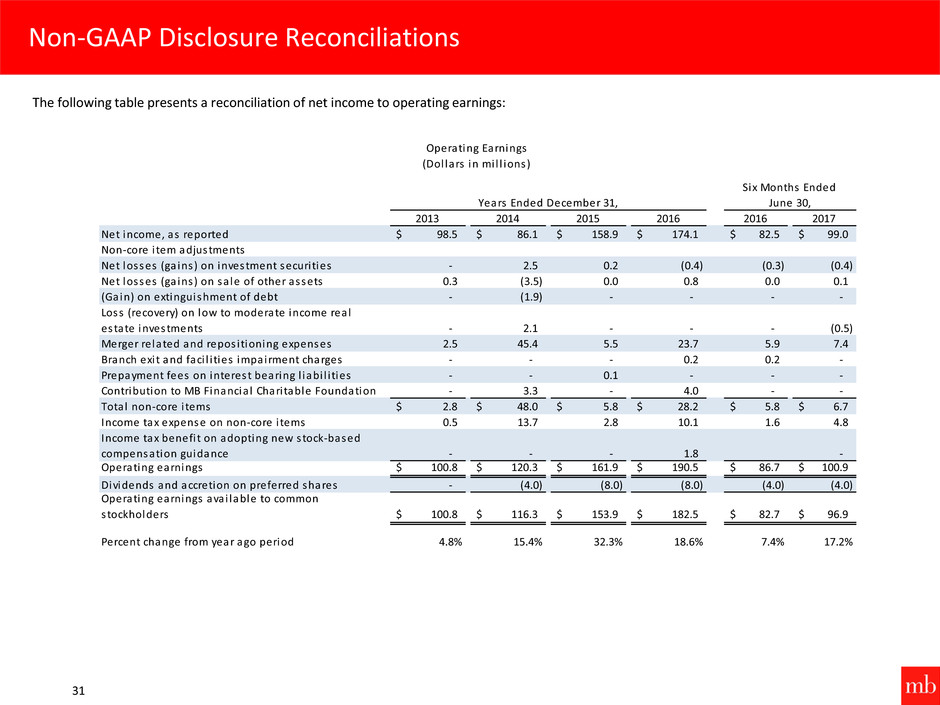
Non-GAAP Disclosure Reconciliations
31
2013 2014 2015 2016 2016 2017
Net income, as reported $ 98.5 $ 86.1 $ 158.9 $ 174.1 $ 82.5 $ 99.0
Non-core i tem adjustments
Net losses (ga ins ) on investment securi ties - 2.5 0.2 (0.4) (0.3) (0.4)
Net losses (ga ins ) on sa le of other assets 0.3 (3.5) 0.0 0.8 0.0 0.1
(Gain) on extinguishment of debt - (1.9) - - - -
Loss (recovery) on low to moderate income real
estate investments - 2.1 - - - (0.5)
Merger related and repos i tioning expenses 2.5 45.4 5.5 23.7 5.9 7.4
Branch exi t and faci l i ties impairment charges - - - 0.2 0.2 -
Prepayment fees on interest bearing l iabi l i ties - - 0.1 - - -
Contribution to MB Financia l Chari table Foundation - 3.3 - 4.0 - -
Total non-core i tems $ 2.8 $ 48.0 $ 5.8 $ 28.2 $ 5.8 $ 6.7
Income tax expense on non-core i tems 0.5 13.7 2.8 10.1 1.6 4.8
Income tax benefi t on adopting new stock-based
compensation guidance - - - 1.8 -
Operating earnings $ 100.8 $ 120.3 $ 161.9 $ 190.5 $ 86.7 $ 100.9
Dividends and accretion on preferred shares - (4.0) (8.0) (8.0) (4.0) (4.0)
Operating earnings avai lable to common
stockholders $ 100.8 $ 116.3 $ 153.9 $ 182.5 $ 82.7 $ 96.9
Percent change from year ago period 4.8% 15.4% 32.3% 18.6% 7.4% 17.2%
Operating Earnings
(Dol lars in mi l l ions)
Years Ended December 31,
Six Months Ended
June 30,
The following table presents a reconciliation of net income to operating earnings:
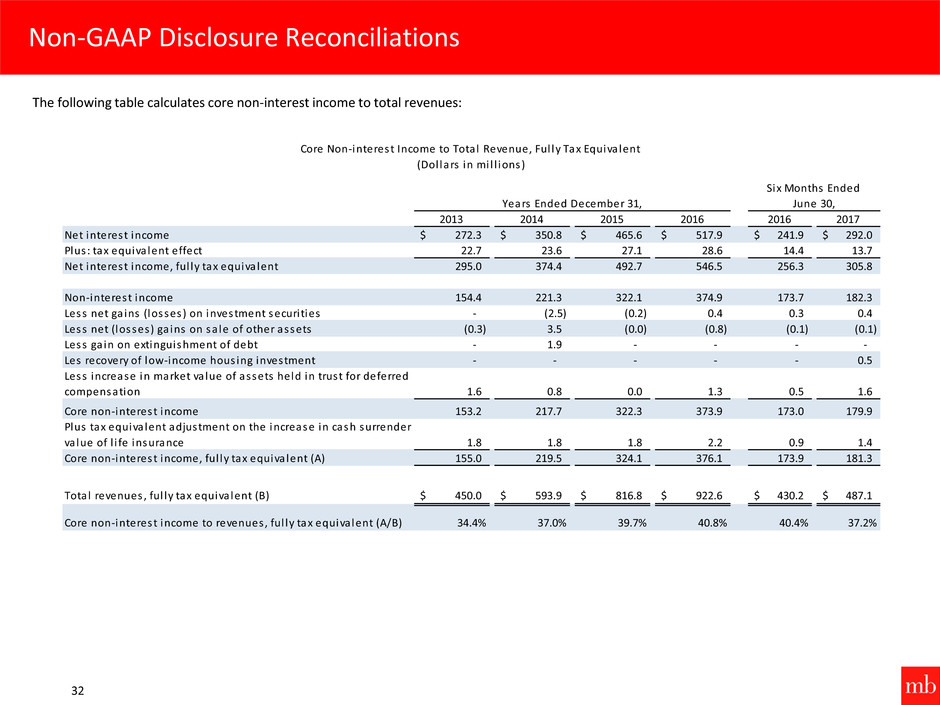
Non-GAAP Disclosure Reconciliations
32
2013 2014 2015 2016 2016 2017
Net interest income $ 272.3 $ 350.8 $ 465.6 $ 517.9 $ 241.9 $ 292.0
Plus : tax equiva lent effect 22.7 23.6 27.1 28.6 14.4 13.7
Net interest income, ful ly tax equiva lent 295.0 374.4 492.7 546.5 256.3 305.8
Non-interest income 154.4 221.3 322.1 374.9 173.7 182.3
Less net ga ins (losses) on investment securi ties - (2.5) (0.2) 0.4 0.3 0.4
Less net (losses) ga ins on sa le of other assets (0.3) 3.5 (0.0) (0.8) (0.1) (0.1)
Less ga in on extinguishment of debt - 1.9 - - - -
Les recovery of low-income hous ing investment - - - - - 0.5
Less increase in market va lue of assets held in trust for deferred
compensation 1.6 0.8 0.0 1.3 0.5 1.6
Core non-interest income 153.2 217.7 322.3 373.9 173.0 179.9
Plus tax equiva lent adjustment on the increase in cash surrender
va lue of l i fe insurance 1.8 1.8 1.8 2.2 0.9 1.4
Core non-interest income, ful ly tax equiva lent (A) 155.0 219.5 324.1 376.1 173.9 181.3
Total revenues , ful ly tax equiva lent (B) $ 450.0 $ 593.9 $ 816.8 $ 922.6 $ 430.2 $ 487.1
Core non-interest income to revenues , ful ly tax equiva lent (A/B) 34.4% 37.0% 39.7% 40.8% 40.4% 37.2%
Core Non-interest Income to Total Revenue, Ful ly Tax Equiva lent
(Dol lars in mi l l ions)
Years Ended December 31,
Six Months Ended
June 30,
The following table calculates core non-interest income to total revenues:
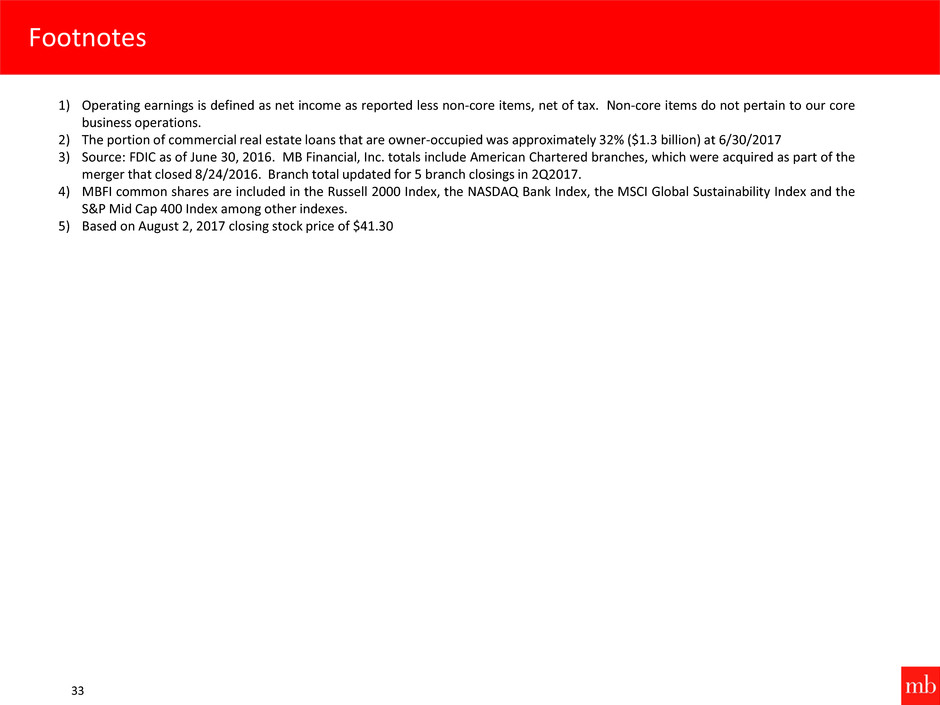
Footnotes
33
1) Operating earnings is defined as net income as reported less non-core items, net of tax. Non-core items do not pertain to our core
business operations.
2) The portion of commercial real estate loans that are owner-occupied was approximately 32% ($1.3 billion) at 6/30/2017
3) Source: FDIC as of June 30, 2016. MB Financial, Inc. totals include American Chartered branches, which were acquired as part of the
merger that closed 8/24/2016. Branch total updated for 5 branch closings in 2Q2017.
4) MBFI common shares are included in the Russell 2000 Index, the NASDAQ Bank Index, the MSCI Global Sustainability Index and the
S&P Mid Cap 400 Index among other indexes.
5) Based on August 2, 2017 closing stock price of $41.30

August 2017
NASDAQ: MBFI
Investor Presentation
SIGNATURES
Pursuant to the requirements of the Securities Exchange Act of 1934, the registrant has duly caused this report to be signed on its behalf by the undersigned hereunto duly authorized.
MB FINANCIAL, INC. | ||||
Date: | August 9, 2017 | By: | /s/Randall T. Conte | |
Randall T. Conte | ||||
Vice President and Chief Financial Officer | ||||
(Principal Financial Officer) | ||||
